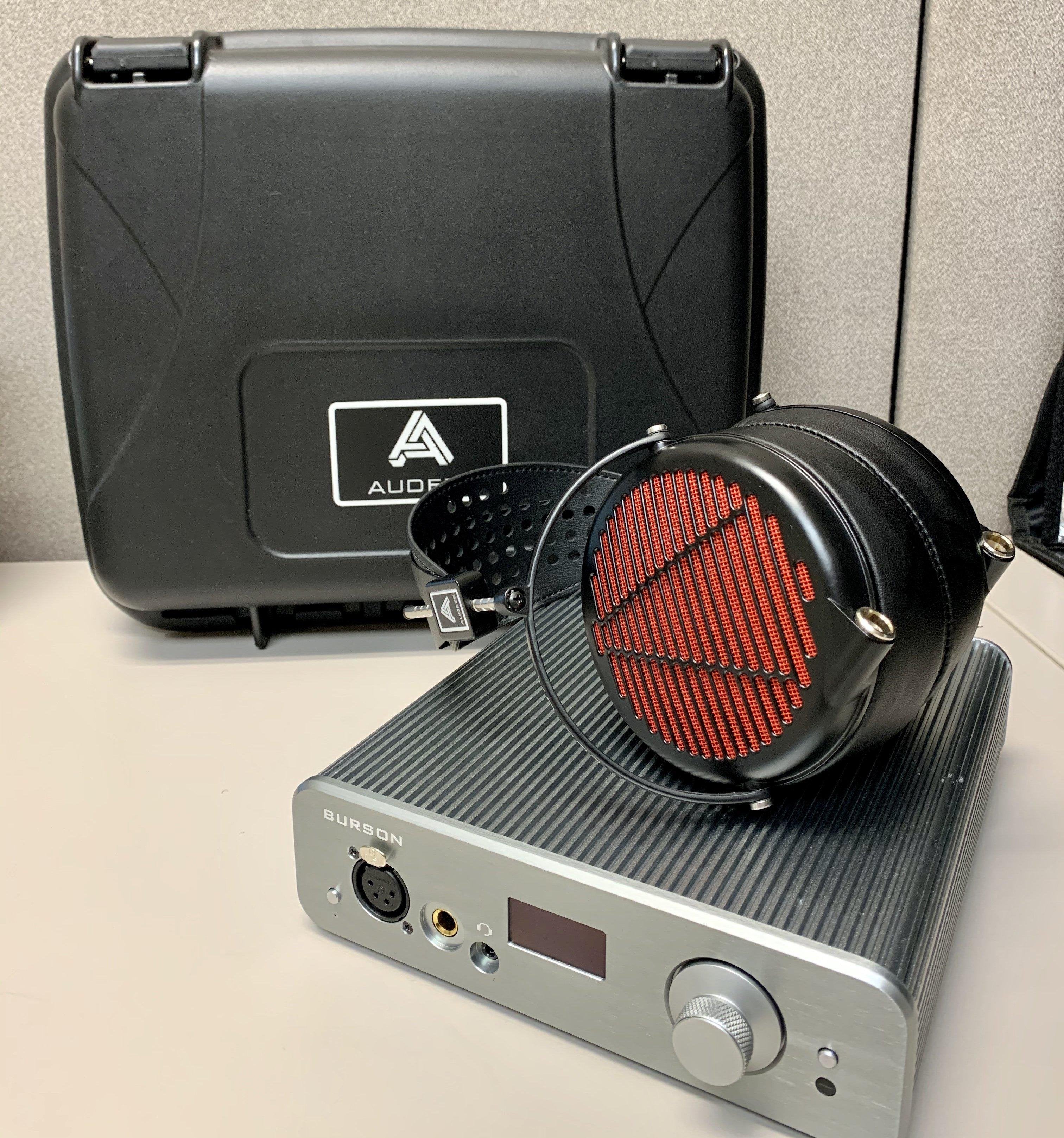After the success of the Mobius gaming headphones, Audeze decided to take things a step further and push high end audiophile sound into a gaming headset. The result is the Audeze LCD-GX. Based on the LCD series and with a new lightweight design, the LCD-GX strives to be a great gaming headset, and a top notch audiophile headphone. Can it do both? Or is it just another set of expensive headphones with a mic attachment?
Build and Design
The LCD-GX comes packaged in a hard shell travel case, which would be perfect for bringing to LAN parties (if anyone actually does LAN parties any more). It includes a standard Audeze cable with a 6.3mm plug, as well as a 3-ring 3.5mm stereo + microphone plug (and a splitter if your hardware has separate mic and headphone inputs). If you’re not going to use it for gaming, I’d recommend using the standard cable if possible (with an adapter if necessary), as the mic cannot be removed from the 3.5mm cable, and the 6.3mm cable is a bit more robust and tangle resistant.
One of the features that distinguishes the LCD-GX from the rest of the LCD line – whether you want to use it for gaming or not – is the weight. Coming in 200-300 grams lighter than other offerings in the LCD line (excepting the LCD-1), the GX feels like a featherweight compared to even the LCD-X. This is a boon both for gamers running raids or a long night of competitive ladder play, as well as audiophiles who want to do extended listening sessions without getting a neck workout. Otherwise the general build and design is similar to other LCD series headphones in the general price range: it has the standard headband adjustment; very solid construction, which uses metal instead of plastic in most places; and comfortable, roomy, leather earcups.
Another thing to note about the LCD-GX is that it’s incredibly easy to drive for a planar magnetic headphone. I was able to drive it easily off my laptop, phone, and even through the headphone jack on a wireless PS4 controller, and get ample volume out of each source.
The Sound
The LCD-GX balances the needs of gaming with a sound profile that’s also very enjoyable for music. When you’re listening to music, having an ample soundstage and good sense of spatial positioning helps put you in the middle of the music, and create a feeling like you’re right there in the studio. With gaming, it’s important for awareness of your surroundings, and – particularly in competitive games – helps you locate and respond to your opponents more quickly in fast paced games. With music, coherence, detail, and separation provide a listening experience where you can pick out every instrument, every voice, and every noise. With gaming, it helps balance voice chat, in game sounds, and the in-game music, without anything becoming muddy or difficult to hear. And let’s not forget, the music itself is a big part of the experience for many single-player and story-driven games. The more you think about it, the headphone needs of music-lovers and gamers aren’t that different.
Music
For music, the LCD-GX has a very balanced neutral presentation, with a soundstage that feels “just right.” The lows of plenty of thump and thickness, and the 106mm transducers can certainly get a little bit of air moving. The highs are clear and airy with a slight roll off around 10k. While some headphones give you the feeling of an endless soundstage or a massive cathedral, the LCD-GX feels like a medium sized club. There’s a definite sense of space, just not too much, and the imaging is excellent inside that space.
On “Doin’ Something” by Soullive, you can really get feel for the LCD-GX’s ability to groove. The coupling of the bass drum and bass guitar is tight, physical, and coherent. The funky, percussive guitar line hits just above it, flowing in and out against the cymbals and snare with the organ holding everything together. Then on top of that, the horns are nice and up in front, but the stabs remain musical with the highest frequencies being sufficiently tempered. Similarly on Lauryn Hill’s “Doo Wap (That Thing)” the groove is thick, pushing air into your ears, while the interplay between rapped and sung vocals is clear, with the LCD-GX revealing detail in the harmonies and vocal counterpoint.
With something softer and slower-building like Sigur Rós’ “Svefn-G-Englar,” the layers of padded synths and ambient guitar fill your airs and envelop you like a soft cushion of sound as Jónsi’s vocals pull you upward. Every aspect of the music feels perfectly balanced in the LCD-GX, and the imaging and space is demonstrated as sounds move from left to right and then to center as if they’re bouncing around an empty room.
On Iron Maiden’s “Caught Somewhere in Time” the dueling, harmonizing guitars feel big and up front in the intro, but are pulled in as the verse starts. It’s a very busy song, but the LCD-GX keeps everything coherent and provides good separation of the various guitar parts as they cross over the bass. You don’t miss a beat as the energetic push and pull of the galloping rhythm drives the song forward. There’s also a great sense of space: the band feels like they’re filling up a stage – not playing in a closet on the one extreme, or floating on an asteroid through an infinite void on the other.
Gaming
There are two main aspects that I focused on for gaming with the LCD-GX: sound quality during gameplay, and the quality of the microphone for voice chat or streaming. Most of my gameplay was done through a Playstation 4, using the headphone jack on the wireless controller. Right off the bat, it’s impressive that planar magnetic headphones can be sensitive enough to be driven by such a low output source. The microphone is really solid and clear for voice chat, and I didn’t have any issues with it picking up the room or – with these being open-back – any issues with game audio getting picked up by the mic. I also did some basic recording tests, and found that while I wouldn’t use it over a dedicated mic for recording, it’s certainly good enough that if you’re streaming for a modest following, no one is going to complain about your mic quality.
As far as in game sound quality, the LCD-GX was an absolute revelation. Compared to my mid-fi home theater setup (admittedly it’s more tuned towards trying to shake the entire house when something blows up in an Avengers movie than having a clear balanced output), the LCD-GX provided significantly more detail, and I heard environmental sounds and cues much more clearly. I primarily tested the LCD-GX with Destiny 2, and found that I heard little details that I had never noticed before. Details like the difference in gun sounds between firing in an open area vs. firing in a cave, the footstep sounds of cloaked enemies, or how easy it was to determine the position of an enemy sniper based on the sound of their gun. I’m not going to say that the LCD-GX will “take your games to the next level” or “give you the competitive edge over your opponents,” but the tuning, soundstage, and power needs were all clearly balanced with gaming in mind, and are absolutely top notch.
Comparison: LCD-X
Since the LCD-GX has a more neutral, reference like tuning, the other more neutral, referenced Audeze headphones, the LCD-X, is a good comparison point. The LCD-GX is $899, while the LCD-X runs $1199. Considering the additional features, and lightweight nature of the LCD-GX, how does it stack up against the LCD-X for music?
Probably the most noticeable difference between the two is that the LCD-X has a more robust low-end, while the LCD-GX has a bit more brightness. Going back through the my reference tracks for the LCD-GX with the LCD-X there were some common themes: there was more bass presence and a touch more detail in the mids, but a little more rolloff in the highs. This resulted in instruments like the horns on Soullive’s “Doin’ Something” being a little less front and center, and placed the lead guitars on “Caught Somewhere in Time” further back with the band. The difference in bass was most noticeable on the Sigur Rós and Lauryn Hill tracks, which utilized more subbass as both headphones have a similar “thump” in the 60-200Hz range, but the LCD-X had better extension down into the 20-40 Hz range.
In terms of the physical properties of the headphones themselves, the LCD-GX gets a clear win for weight and comfort. While the LCD-X isn’t particularly heavy by planar magnetic headphone standards, the LCD-GX is about 30% lighter, and felt more comfortable for longer listening sessions. Overall, I preferred the sound of the LCD-X, but the price, comfort, and gaming features (and the nice case) make the LCD-GX a compelling package.
The Bottom Line
If you’re looking specifically for an audiophile gaming headset, the LCD-GX is possibly the most complete audiophile sound in a gaming headset on the market. If you’re looking for planar magnetic headphones under $1000 – and one that’s easy to drive from any source, at that – the LCD-GX is a great pick as a more neutral, reference tuned alternative to the Audeze LCD-2. The LCD-GX tries to carefully balance the needs of gamers with the needs of audiophiles, and ends up being a big win for both.








